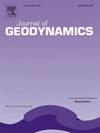Earthquake swarms in West Bohemia are most likely not rain triggered
Abstract
Water levels in anthropogenic reservoirs are often studied in terms of the influence of their fluctuation to pressure perturbations in the bedrock and possible triggering of nearby seismic activity. In this paper, we examine the possibility of a similar relationship in the West Bohemia/Vogtland region on the border of the Czech Republic and Germany. This area is well known for the occurrence of earthquake swarms that are located mainly around Nový Kostel village with the Horka dam nearby, just 5 km to the E-SE of the seismogenic zone. We are looking for any evidence of a mutual relationship between rainfall and the water level at the Horka dam and the seismic catalog that contains more than 25,000 nearby events for the period 1995 − 2019. For this purpose, we applied the methods of cross-correlation and Singular Spectrum Analysis (SSA). The analysis was performed on both full and declustered seismic catalogs and on the full time series and the series averaged over a single-year period. No significant correlation was found between the hydrologic and seismic data; the seismic activity occurs randomly in time. The SSA method found strong seasonal variations of the water level in the dam with annual periodicity; however, no similar periodicity was found in the rainfall and seismicity data. Our results show that not only the earthquake swarms, but also the background seismic activity have no relationship to the rainfall or water level in the Horka dam. The hypothesis of hydrologic triggering of the seismic activity in the area appears rather unlikely and other mechanisms should be studied in more detail to account for the earthquake swarms’ occurrence.

 求助内容:
求助内容: 应助结果提醒方式:
应助结果提醒方式:


